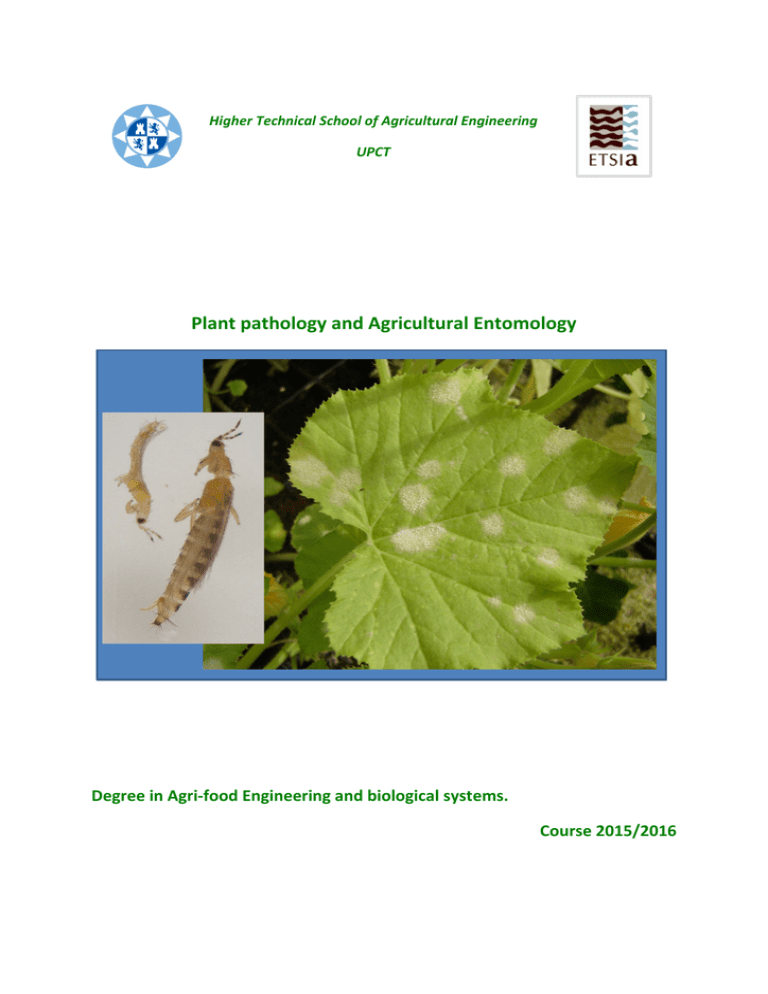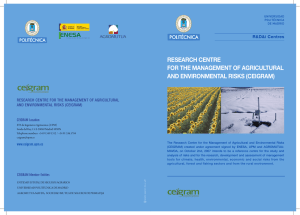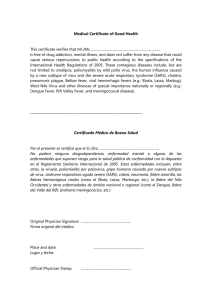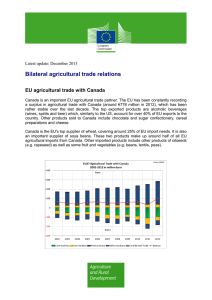Plant pathology and Agricultural Entomology
Anuncio

Higher Technical School of Agricultural Engineering UPCT Plant pathology and Agricultural Entomology Degree in Agri-food Engineering and biological systems. Course 2015/2016 1. Subject information Name Plant pathology and Agricultural Entomology Matter* Plant pathology and Agricultural Entomology Module* Code Degree Study plan Centre Type Teaching period Language ECTS 6 specific 518104008 Degree in Agi-food Engineering and biological systems 2013 Higher Technical School of Agricultural Engineering (ETSIA) Compulsory Four-month period Four-month period 1st Course 4th Spanish Hours / ECTS 30 Total workload (hours) 180 * All terms marked with an asterisk are defined in References for teaching at the UPCT and Glossary of terms: http: // repository.bib.upct.es/dspace / bitstream / 10317/3330/1 / isbn8469531360.pdf 2. Teacher information Lecturer in charge Juan Antonio Martinez Lopez Department Plant Production Knowledge area Plant Production Location of the office ETSIA building office 1.42 Phone 968 325765 E-mail [email protected] URL / WEB Location during the tutorials Teaching experience Lines of investigation Professional experience Other topics of interest Professor Monday: 12.00 - 14.00 h. Wednesday: 12.00 - 14.00 and 16.00 - 18.00 h. ETSIA building office 1.42 Plant Pathology, Pathology of post-harvest, physiology and technology of post-harvest Since 1999 UPCT Plant pathology and pathology of post-harvest Science and technology of conservation horticulture Teaching in numerous training courses and development of contracts advisory and research with companies in the horticultural sector Dina Cifuentes Romo Department Plant Production Knowledge area Plant Production Location of the office ETSIA building office 1.6 Phone 968-325449 / 868-071155 E-mail [email protected] URL / WEB 968 325433 http://www.upct.es/~dpv/ Timetable available/ Tutorials Teaching and research profile Fax Fax http://www.upct.es/~dpv/ Timetable available/ Tutorials Location during the tutorials appointment by email with student ETSIA building office 1.6 968 325433 Teaching and research profile Teaching experience Lines of investigation Professional experience Other topics of interest Plant Pathology, Agricultural Entomology, Molecular Markers Plant Pathology, Agricultural Entomology Plant Pathology, Agricultural Entomology, Molecular Markers Plant Pathology, Agricultural Entomology Pest resistance to pesticides 3. Contents 3.1 Contents curriculum related to the subject The course consists of two thematic blocks; one studies the basic aspects of plant pathology and another does the same with entomology. Plant Pathology block consists of two distinct parts, but the first is the basis for understanding the following. Classification, diagnosis, biological, physiological, ecological and epidemiological diseases and control methods: In the first part the general aspects of plant pathology and are being studied. The second part describes the main plant diseases specific to deepen the study of the characteristics of the pathogens involved, classification, symptomatology, identification and description of diseases. In the second thematic block were selected for study mainly by the negative economic impact on crop production of two groups pest organisms; insects and mites. Morphological, biological, damage to crops and forms of control available features will be studied. 3.2 Internship Program (Name and description each practice) 3.2.1 Laboratory practices which are studied diseased or parasitized plants to finally make a diagnosis based on symptoms and / or specific analysis. 3.2.2 Individually develop an insectarium pest in the Agricultural Entomology block. 3.3 English program theory (Teaching units and topics) SECTION I: Phytopathology PART 1: GENERAL ASPECTS OF DISEASES AND THEIR CONTROL LESSON 1: DISEASES AND Phytopathology PART 2: SPECIFIC PLANT DISEASES LESSON 2: Plant Diseases Caused by fungi LESSON 3: Plant Diseases Caused by bacteria LESSON 4: Plant Diseases Caused by Virus LESSON 5: Plant Diseases Caused by nematode SECTION II: AGRICULTURAL ENTOMOLOGY LESSON 6: Insects: General features and agricultural Implications LESSON 7: Coleoptera: General Characteristics and Most Important agricultural pests LESSON 8: Lepidoptera: General Characteristics and Most Important agricultural pests LESSON 9: Diptera: General Characteristics and Most Important agricultural pests LESSON 10: Thysanoptera: General Characteristics and Most Important agricultural pests LESSON 11: The Homoptera group of Hemiptera: General Characteristics and Most Important agricultural pests LESSON 12: Acari: General Characteristics. Actinedida limits for pest control 4. Bibliography and resources 4.1 Basic bibliography* • AGRIOS, G.N. 2000. Fitopatología. 2ª ed. Limusa. • AGRIOS, G.N. 2005. Plant Pathology. 5th ed. Ed. Elsevier. • DE LIÑÁN, C. 1998. Entomología Agroforestal. Insectos y ácaros que dañan montes, cultivos y jardines. Ed. Aerotécnicas. You can access the location of the literature from the following link: http://unicorn.bib.upct.es/uhtbin/cgisirsi/upct/SALA1/0/1/2577/X 4.2 Complementary bibliography * • AlBOUY, J., DEVERGNE, J.C. 2000. Enfermedades producidas por virus en plantas ornamentales. Ediciones Mundi – Prensa. • BARBERÁ, C. 1989. Pesticidas agrícolas. Ed. Omega. • BIADENE, G. 1998. Las enfermedades de la patata. Ed. Mundi – Prensa. • BLANCARD, D., LECOG, H., PITRAT, M., JAVOY, M. 2000. Enfermedades de las cucurbitáceas. Institut National de la Recherche Agronomique. INRA. Ed. Mundi – Prensa. • DAUGHTREY, M.L., WICK, R.L., PETERSON, J.L.2001. Plagas y enfermedades de las plantas en maceta con flores. The American Phytopathological Society. APSnet. Ed. Mundi – Prensa. • DAVIS, R.M., SUBBARAO, K.V., RAID, R.N., KURTZ, E.A. 2002. Plagas y enfermedades de la lechuga. The American Phytopathological Society. APSnet. Ed. Mundi – Prensa. • DURÁN-VILA, N., MORENO, P. 2000. Enfermedades de los cítricos. Sociedad Española de Fitopatología. SEF. Ed. Mundi – Prensa. • GARCÍA, F., COSTA, J., FERRAGUT, F. 1994. Las plagas agrícolas. Ed. Agropubli. • GARCÍA, F., COSTA, J., FERRAGUT, F., LLORENS, J.M. 1991. Ácaros de las plantas cultivadas y su control biológico. Ed.Pisa. • HANSEN, E.M., LEWIS, K.J. 2003. Plagas y enfermedades de las coníferas. The American Phytopathological Society. APSnet. Ed. Mundi – Prensa. • JONES, J.B. 2001. Plagas y enfermedades del tomate. The American Phytopathological Society. APSnet. Ed. Mundi – Prensa. • JONES, A.L., Aldwinckle, H.S. 2002. Plagas y enfermedades del manzano y del peral. The American Phytopathological Society. APSnet. Ed. Mundi – Prensa. • LLÁCER, G., López, M.M., Trapero, A., Bello, A. 2000. Patología vegetal. Tomo I y II. Sociedad Española de Fitopatología SEF. • MELGAREJO, P. Y OTROS. 2010, Patógenos de plantas descritos en España. 2ª ed. Ministerio de Medioambiente y Medio Rural y Marino. • MONTESINOS, E., MELGAREJO, P., CAMBRA; M.A., PINOCHET, J. 2000. Enfermedades de los frutales de pepita y de hueso. Sociedad Española de Fitopatología. SEF. Ed. Mundi – Prensa. • PEARSON, R.C., GOHEEN, A.C. 2007. Plagas y enfermedades de la vid. The American Phytopathological Society. APSnet. Ed. Mundi – Prensa. • SMILEY, R.W., DERNOEDEN, P.H., CLARKE, B.B. 2007. Plagas y enfermedades de los céspedes. The American Phytopathological Society. APSnet. Ed. Mundi – Prensa. • TORRES, J. 2003. Patología forestal. 2ª ed. Ed. Mundi – Prensa. • WHITE, D.G., 2004. Plagas y enfermedades del maíz. The American Phytopathological Society. APSnet. Ed. Mundi – Prensa. • ZITTER, T.A., HOPKINS, D.L., THOMAS, C.E. 2004. Plagas y enfermedades de las cucurbitáceas. The American Phytopathological Society. APSnet. Ed. Mundi – Prensa. 4.3 Network resources and other resources • http://www.inra.fr • http://www.ipm.ucdavis.edu/PMG/ crops-agriculture.html • http: // ianrwww.unl.edu/ianr/plntpath/nematode/wormhome.htm • http://plantprotection.org/IRAC/ • Plant Viruses Online • http://biology.anu.edu.au/Groups/MES/vide/refs.htm • http://www.koppert.nl • http://www.biobest.be/index_sp.htm • http://www.fungionline.org.uk • http://www.ipmimages.org • http://www.apsnet.org • http://www.sef.es


